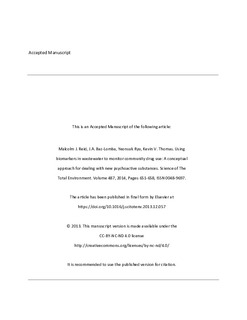| dc.contributor.author | Reid, Malcolm James | |
| dc.contributor.author | Baz Lomba, Jose Antonio | |
| dc.contributor.author | Ryu, Yeonsuk | |
| dc.contributor.author | Thomas, Kevin V | |
| dc.date.accessioned | 2018-10-12T07:00:21Z | |
| dc.date.available | 2018-10-12T07:00:21Z | |
| dc.date.created | 2014-12-06T13:06:05Z | |
| dc.date.issued | 2014 | |
| dc.identifier.citation | Science of the Total Environment. 2014, 487 (1), 651-658. | nb_NO |
| dc.identifier.issn | 0048-9697 | |
| dc.identifier.uri | http://hdl.handle.net/11250/2567736 | |
| dc.description.abstract | Data obtained from the analysis of wastewater from large-scale sewage treatment plants has been successfully applied to study trends in the use of classical illicit drugs such as cocaine, but the dynamic nature of the new psychoactive substances (NPS) market presents a unique set of challenges to epidemiologists. In an attempt to overcome some of the challenges, this paper presents a framework whereby a collection of tools and alternative data-sources can be used to support the design and implementation of wastewater-based studies on NPS use. Within this framework the most likely and most suitable biomarkers for a given NPS are predicted via in-silico metabolism, biotransformation and sorption models. Subsequent detection and confirmation of the biomarkers in samples of wastewater are addressed via high-resolution mass spectrometry (HRMS).
The proposed framework is applied to a set of test substances including synthetic cannabinoids and cathinones. In general, the in-silico models predict that transformation via N-dealkylation and hydroxylation is likely for these compounds, and that adsorption is expected to be significant for cannabinoids in wastewater. Screening via HRMS is discussed with examples from the literature, and common-fragment searching and mass-defect filtering are successfully performed on test samples such that spectral noise is removed to leave only the information that is most likely to be related to the NPS biomarkers. HRMS screening is also applied to a set of pissoir-sourced wastewater samples and a total of 48 pharmaceuticals and drugs including 1-(2-methoxyphenyl)piperazine (oMeOPP) are identified.
The framework outlined in this paper can provide an excellent means of maximizing the chances of success when identifying and detecting biomarkers of NPS in wastewater. | nb_NO |
| dc.language.iso | eng | nb_NO |
| dc.publisher | Elsevier | nb_NO |
| dc.rights | Attribution-NonCommercial-NoDerivatives 4.0 Internasjonal | * |
| dc.rights.uri | http://creativecommons.org/licenses/by-nc-nd/4.0/deed.no | * |
| dc.title | Using biomarkers in wastewater to monitor community drug use: A conceptual approach for dealing with new psychoactive substances | nb_NO |
| dc.title.alternative | Using biomarkers in wastewater to monitor community drug use: A conceptual approach for dealing with new psychoactive substances | nb_NO |
| dc.type | Journal article | nb_NO |
| dc.type | Peer reviewed | nb_NO |
| dc.description.version | acceptedVersion | nb_NO |
| dc.rights.holder | © 2013 Elsevier | nb_NO |
| dc.source.pagenumber | 651-658 | nb_NO |
| dc.source.volume | 487 | nb_NO |
| dc.source.journal | Science of the Total Environment | nb_NO |
| dc.source.issue | 1 | nb_NO |
| dc.identifier.doi | 10.1016/j.scitotenv.2013.12.057 | |
| dc.identifier.cristin | 1181643 | |
| dc.relation.project | Norges forskningsråd: 317205 | nb_NO |
| cristin.unitcode | 7464,0,0,0 | |
| cristin.unitcode | 7464,20,13,0 | |
| cristin.unitname | Norsk institutt for vannforskning | |
| cristin.unitname | Økotoksikologi | |
| cristin.ispublished | true | |
| cristin.fulltext | postprint | |
| cristin.qualitycode | 2 | |

